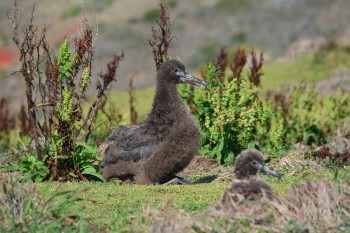Nakodojima Island (1.37 km²) is located in the middle of the Mukojima Island Group of Japan’s Ogasawara (Bonin) Islands. It lies five kilometres south of Mukojima where the Short-tailed Albatross Phoebastria albatrus restoration project is situated. It takes three hours by boat to reach Nakodojima, travelling 50 km north from inhabited Chichijima Island. In the early 1900s, colonists started to farm and ranch on Nakodojima but since World War II the island has been uninhabited.

Short-tailed Albatross chick on Nakodojima Island
Photograph courtesy of the Tokyo Metropolitan Government
Black-footed Albatrosses P. nigripes Albatrosses breed on Nakodojima, with 967 pairs recorded in 2006 according to the ACAP Data Portal. On 7 May this year a Short-tailed Albatross P. albatrus chick close to fledging was found on the island. The bird was colour banded and a feather sample taken for DNA analysis to aid in its positive identification (click here).
Around 30 years ago grazing by feral Domestic Goats Capra aegagrus hircus had seriously damaged the forest on the island resulting in serious erosion. The Tokyo Metropolitan Government (TMG) successfully undertook a feral goat eradication programme that removed 417 animals on Nakodojima from 1997 to 1999, and has managed a forest restoration programme since then. The Black Rat Rattus rattus is now the last remaining introduced mammal on the island
Since 1978 the TMG has monitored the status of Black-footed Albatrosses breeding within the Mukojima Island Group. In the 2004 breeding season the Institute of Boninology (NPO) joined the monitoring programme and started plastic colour banding birds for population analysis. Following eradication of feral goats throughout the Mukojima Island Group the numbers of Black footed Albatrosses have increased gradually in all colonies, and their breeding area is expanding. In May 2014 1040 Black footed and 12 Laysan P. immutabilis Albatross chicks were banded in the Mukojima Island Group.
The Ogasawara Islands were designated as a World Heritage Natural Site in June 2011, with Nakodojima Island being treated as its most restricted area.
A management plan and an action plan for protection and management of property are being implemented by the Ministry of the Environment (Ogasawara National Park, Ogasawara Archipelago National Wildlife Protection Area), Forestry Agency (Ogasawara Islands Forest Ecosystem Reserve), Tokyo Metropolitan Government and Ogasawara Village with the local community’s participation facilitated through a Regional Liaison Committee.
On Nakodojima commercial developments and usage are prohibited and recreational activities are not allowed. Scientists and forest restoration programme managers visit under permit. In order to avoid disturbance to the albatrosses, the forest restoration programme is limited to outside the albatross breeding season.
To improve conservation measures for the Short-tailed Albatross chick found on Nakodojima 2014, a local conference on albatrosses that was organized by local government agencies, NPO, fisheries, tourist group and scientists in 2008, will re-start to discuss implementing a ban of entering the STAL’s breeding site in the coming season.
With thanks to Kazuo Horikoshi, Institute of Boninology and Yoshinori Tamaki, Ogasawara Islands Branch Office, Tokyo Metropolitan Government for information.
Selected Literature:
Government of Japan 2010. Nomination of the Ogasawara Islands for Inscription on the World Heritage List. [Tokyo]: Government of Japan. 228 pp.
Ministry of the Environment 2009. Management Plan for the Ogasawara Islands World Natural Heritage Nominated Site (Draft). Tokyo: Ministry of the Environment. 31 pp. [in Japanese].
John Cooper, ACAP Information Officer, 16 June 2014

 English
English  Français
Français  Español
Español